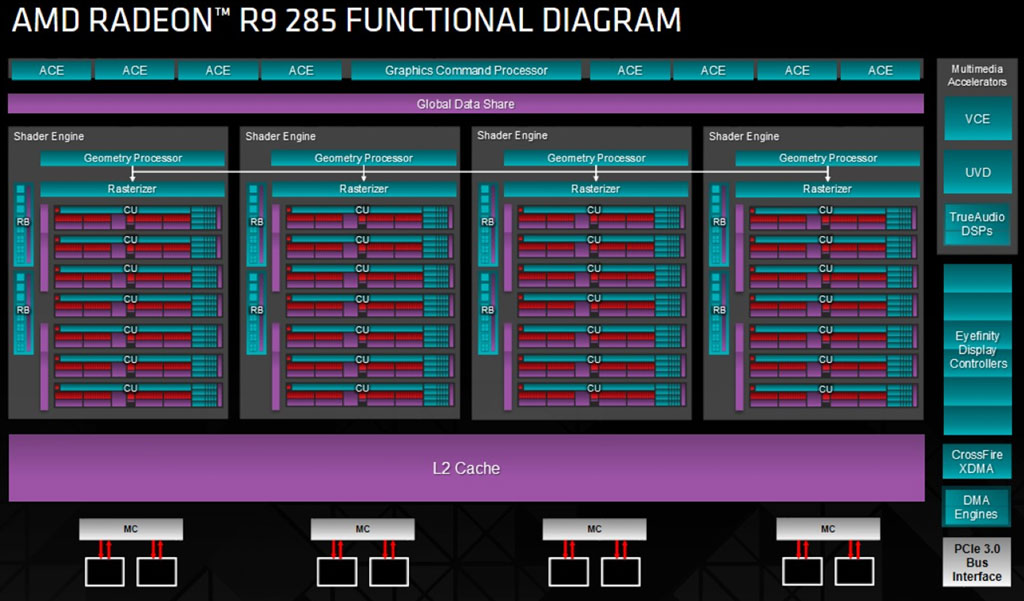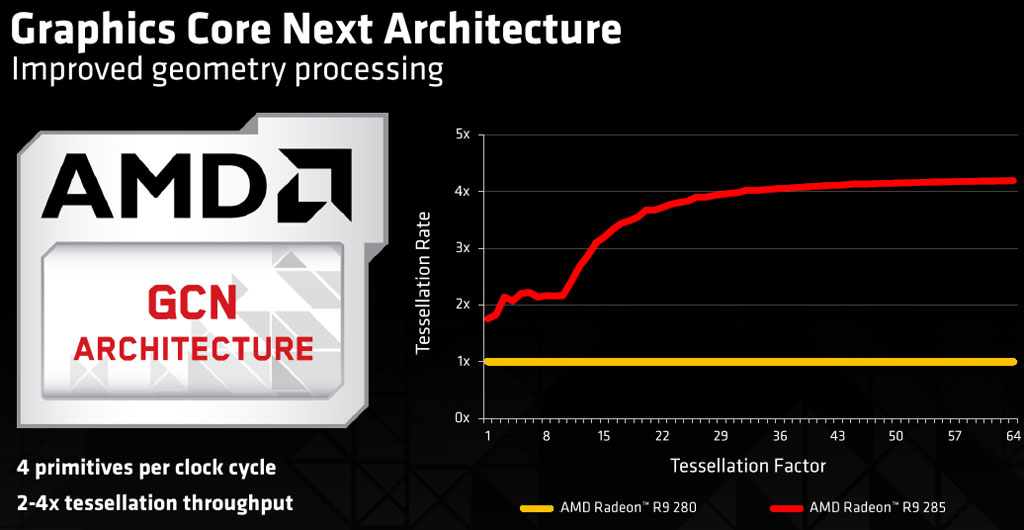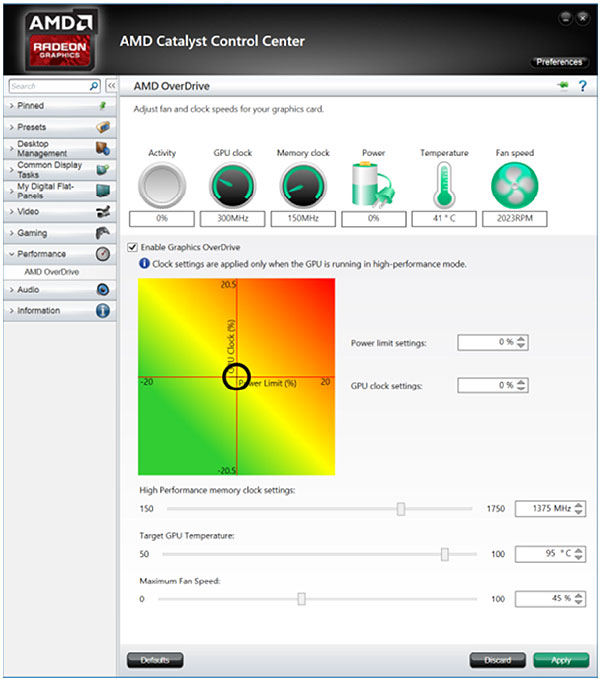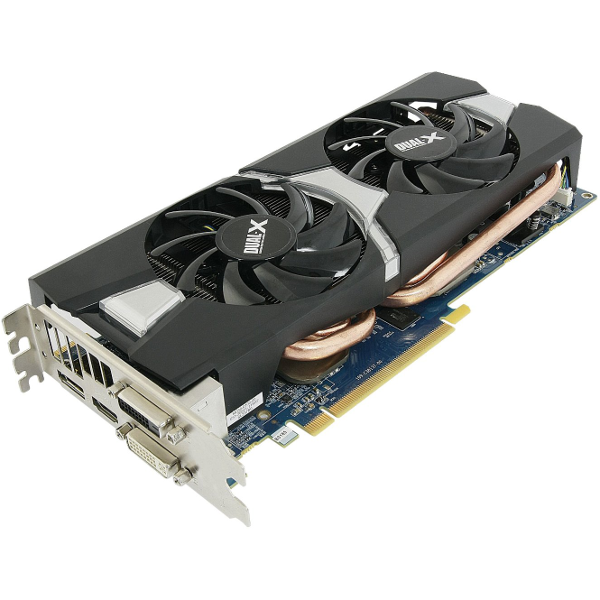Early Verdict
A good $250 replacement for the Radeon R9 280 that doesn't up the ante when it comes to game performance, but adds new features and lower power usage to the mix.
Pros
- +
Performance on par with Radeon R9 280. New features including TrueAudio and bridgeless CrossFire. Lower power usage and improved performance-per-watt.
Cons
- -
Lower raw memory bandwidth than Radeon R9 280 that may result in slightly lower performance in some cases. 2 GB of onboard RAM instead of 3 GB. Does not notably increase performance over Radeon R9 280 on average.
Why you can trust Tom's Hardware
The Radeon's GCN Is Updated Again: The Tonga GPU
When we first heard about the new Radeon R9 285, our first impression was pessimistic. The new Tonga GPU sports specifications that are nearly identical compared to the Radeon R9 280, but with a slightly lower GPU clock and a sizable memory bandwidth deficit thanks to its thinner 256-bit memory interface. While the Radeon R9 285's onboard RAM runs at a higher 1375 MHz clock, the net result is 176 GB/s of memory bandwidth - significantly less than the 240 GB/s memory bandwidth of the R9 280. In addition, the R9 285 has 2 GB of RAM, whereas the R9 280 has 3 GB.
The tale of the tape is not kind to the Radeon R9 285. Yes, the new card's power usage has gone down significantly compared to its predecessor, but from a gaming perspective, that would be small consolation in exchange for lower performance. If raw specifications were all that mattered, and if the Tonga graphics processor was merely a re-spin of the Tahiti GPU in the Radeon R9 280, we wouldn't have a lot of nice things to say about the new Radeon R9 285.
After testing it, though, we were pleasantly surprised to find that the Radeon R9 285 has a few tricks up its sleeve thanks to some re-engineering of the Graphics Core Next (GCN) architecture.

Despite what its specifications may suggest, Tonga is not a spin on the Tahiti GPU in the Radeon R9 280 and 280X. Rather, it is a new and condensed version of the Hawaii GPU in the Radeon R9 290 and 290X. Among other things this means it has four times the number of asynchronous compute engines, that's eight instead of the Radeon R9 280/280X's two. According to AMD this can improve tessellation performance from two to four times, and facilitates effects that rely on GPU compute. In addition, the Radeon R9 285 inherits the 290 series' quad-shader layout, allowing four primitives to be rendered per clock cycle instead of two. Also note the CrossFire XDMA block, which provides the possibility of multi-card operation without a bridge connector.

Tonga features four shader engines, each carrying seven compute units (CUs). Just like previous GCN-based GPUs, every CU is host to 64 shaders and four texture units, adding up to a total of 1792 shaders and 112 texture units in the Radeon R9 285. These numbers are equal to the cut-down Tahiti chip in the Radeon R9 280, but the arrangement of resources is different.
Speaking of cut-down, we're told that Tonga is slightly handicapped for use in the 285, and that the uncut GPU has the potential to utilize eight compute units per shader engine for a total of 2048 shaders and 128 Texture units. If this sounds familiar, it's because this is the same number of resources available in the Radeon R9 280X. Perhaps AMD has some bigger plans for the Tonga GPU in the future.
Regardless, AMD did scale back some parts of the new GPU. Each of the four shader engines carries two render back-ends - instead of four as per the Radeon R9 290 series. Each of these is capable of rendering four full-color pixels per clock, for a total of 32 pixels per clock cycle in total. This is half of what Hawaii can process but equals the Tahiti GPU in the Radeon 280 and 280X.
Get Tom's Hardware's best news and in-depth reviews, straight to your inbox.

Improvements are always welcome but with the memory interface cut by a third compared to the Radeon R9 280, AMD needed to accomplish some magic to compensate for that 27% drop in available bandwidth. The company's solution was to enable the GPU to read and write frame buffer color data in a lossless compressed format, a technique that it claims can deliver 40% higher memory bandwidth efficiency. We're somewhat skeptical that this will completely compensate for the Radeon R9 285's lower available bandwidth compared to the Radeon R9 280, but we'll see what the benchmarks have to say about it.
That's not all that's been improved over the Hawaii GPU in the Radeon 290 series, though. Tonga boasts other new features such as the ability to process instructions in parallel between SIMD lanes, improved compute task scheduling algorithms, and even new 16-bit floating point and integer instructions for compute and media processing tasks.
Of course, Tonga has inherited Hawaii's fixed-function hardware, too, such as TrueAudio (AMD's new audio processor) and project FreeSync (the open-source answer to Nvidia's G-Sync) support. In addition, AMD claims to have revamped the unified video decoder (UVD) and video coding engine (VCE) with improvements specific to the Tonga GPU. The Radeon R9 285's UVD now supports H.264 playback at high frame rates on 4K displays, and the VCE has been improved with faster performance in addition to 4K resolution support. AMD claims a 31%-47% transcoding advantage over the GeForce GTX 760, but we'd prefer to run our own tests on that so expect some in-depth coverage from us in the future.

For the first time, AMD has added the ability to specify the maximum fan speed in the Overdrive overclocking utility. This means that users who prioritize noise can set the maximum fan RPMs, and the driver will automatically adjust clock rates to fit power and heat into the user-specified envelope. This feature will be available in the 14.8 release driver, but only to models with second- and third-iterations of GCN processors: the Radeon R7 260, 260X, R9 285, R9 290, and R9 290X. This functionality didn't seem to work in our pre-release beta driver, unfortunately.
Those are the updated details we have to share from an architectural perspective, now let's get down to the nitty gritty: the test hardware, specifically the Radeon R9 285 card.
Current page: The Radeon's GCN Is Updated Again: The Tonga GPU
Next Page Asus Strix Radeon R9 285Don Woligroski was a former senior hardware editor for Tom's Hardware. He has covered a wide range of PC hardware topics, including CPUs, GPUs, system building, and emerging technologies.
-
JeanLuc The idle power consumption numbers are odd, the previous generation cards use less then at idle didn't they? Not that 15 watts is going to break anyone's bank account but its strange nether the less.Reply
Good to see AMD have tackled the noise and temperature issues that have plagued it's previous 28nm cards as well but it's a bit late in the day given that 20nm shouldn't be to far off now. -
gear999 Really nice article guys. I'm impressed by how the 285 actually was able to keep up with the 280. And I'm shocked by the fact that The $250 Nvidia card loses to a $170 AMD card. Thank god I bought a GTX 770 :PReply
Also, on the last page, you guys wrote R7 270X instead of R9, and in the chart it says "Relative to Radeon HD 7950 Boost". Oh, and in the Pros section, it says the 285 has R9 260 like performance?
Thanks for the proofread, fixing it now! :) -
Mike Stewart wow ! at 250$ it actually is a better card even than 280X !! and it was meant for 760....but as it shows here even a 270X is a WAY better card than 760....Reply -
tomfreak Had the tonga 285 come with a 6GHz/7Ghz GDDR5 & 4GB VRAM, the result will be a lot different. Whats with AMD putting on a 5500 memory? facepalm.jpgReply -
srap While this is really a third GCN iteration, showing it as a version number of 3.0 (as in: "Tonga and GCN Update 3.0") makes no sense for me.Reply -
Amdlova some one write this with a .45 acp on the head. I see some error on numbers models etc...Reply
I prefer get a r9 280 and downclock get same results. I can't see the point of this heat on graphics. maybe drivers. OR THIS IS HAWAII XT! Too much Heat! -
Amdlova ReplyI wanted to see the GPU die and OCing results. :(
I think the guys see if they hit the OC the room Will burn! maybe a problem with drivers.
Last time i see that Heat 290x tests. lol! -
Gillerer On the first page, it says "Improvements are always welcome but with the memory interface cut in half compared to the Radeon R9 280,...".Reply
But in fact, the memory interface was cut by a third (384 bit -> 256 bit), not half.
Good point, fixed! Thx.


